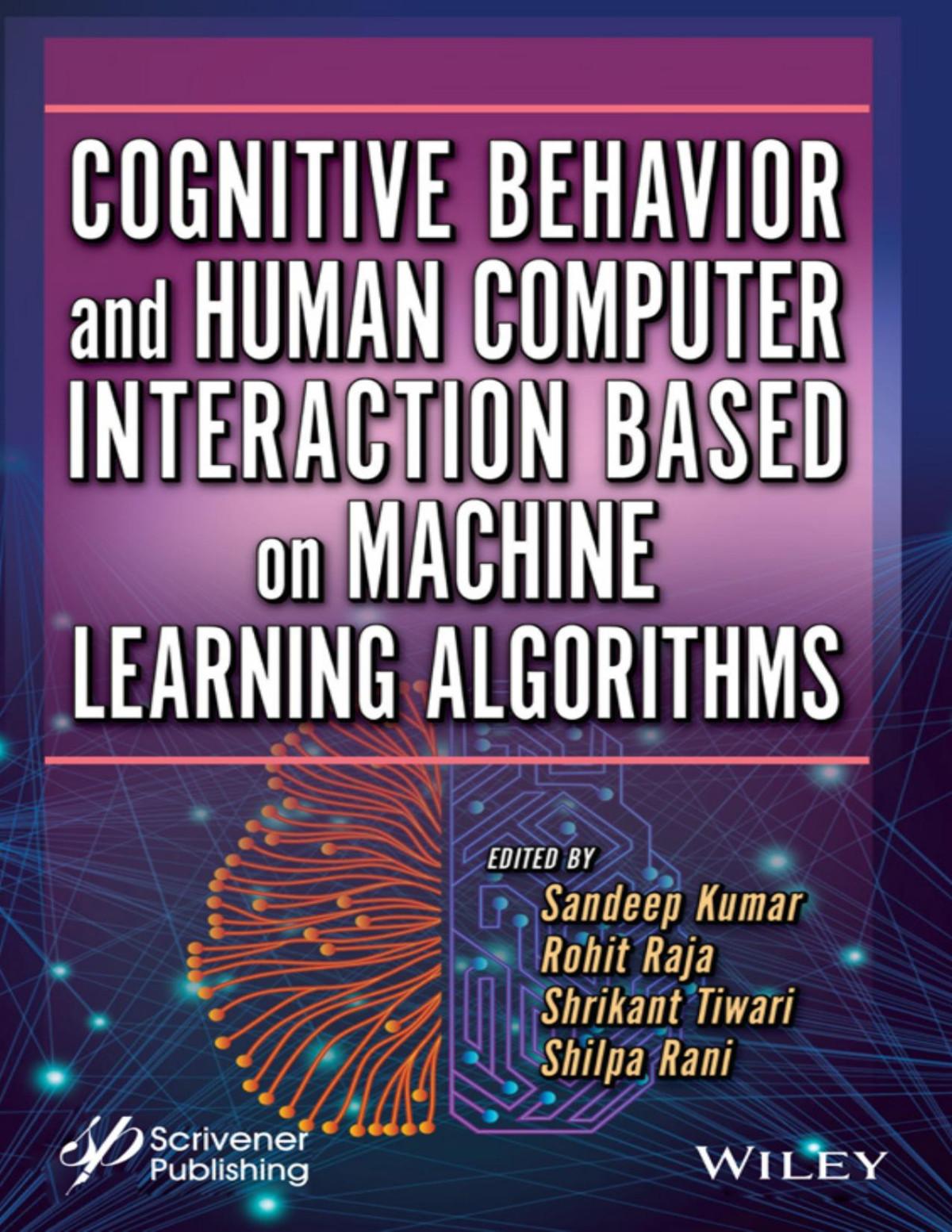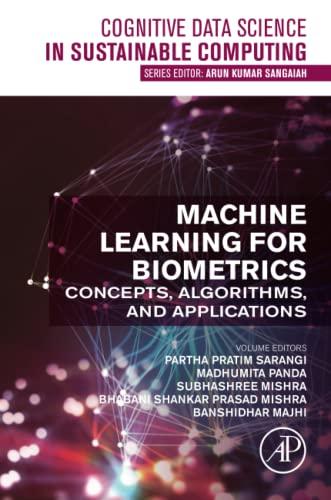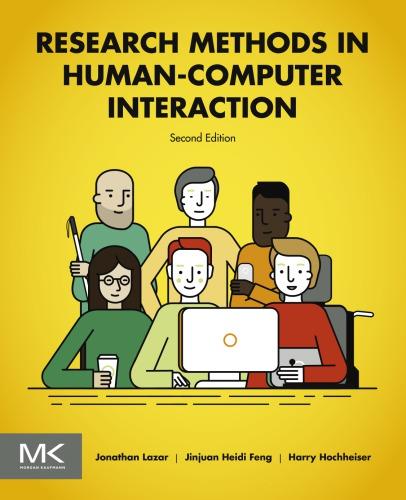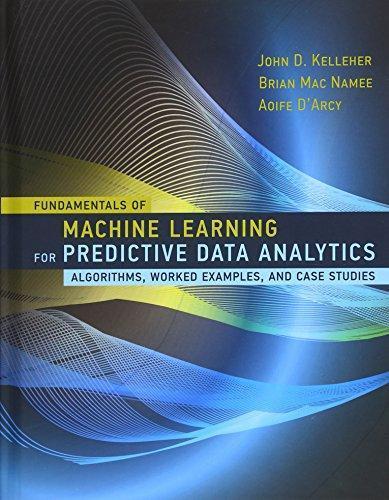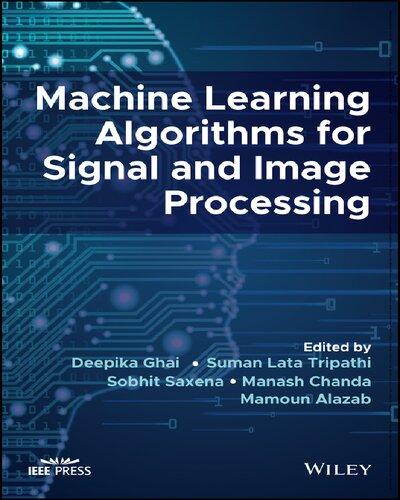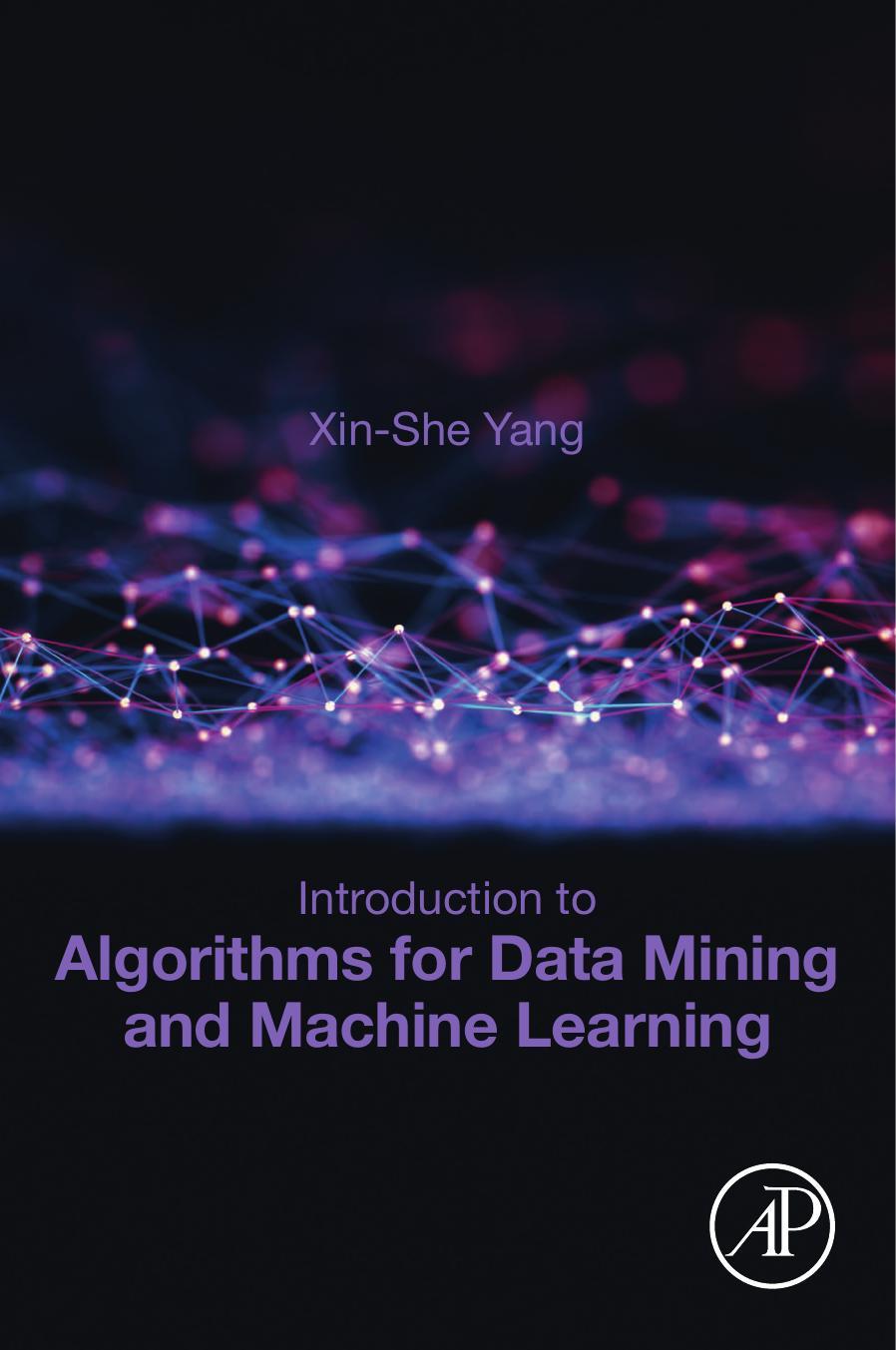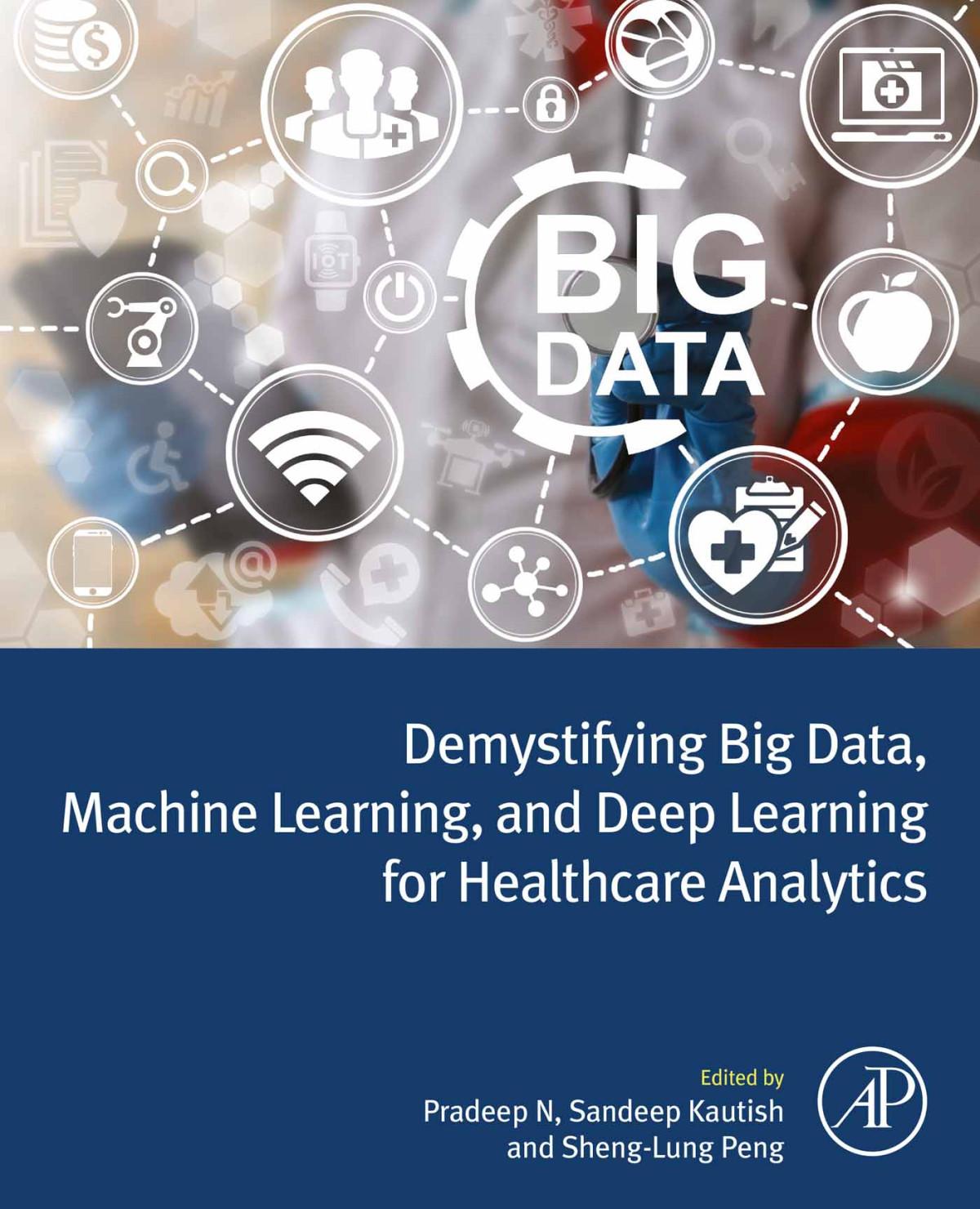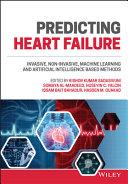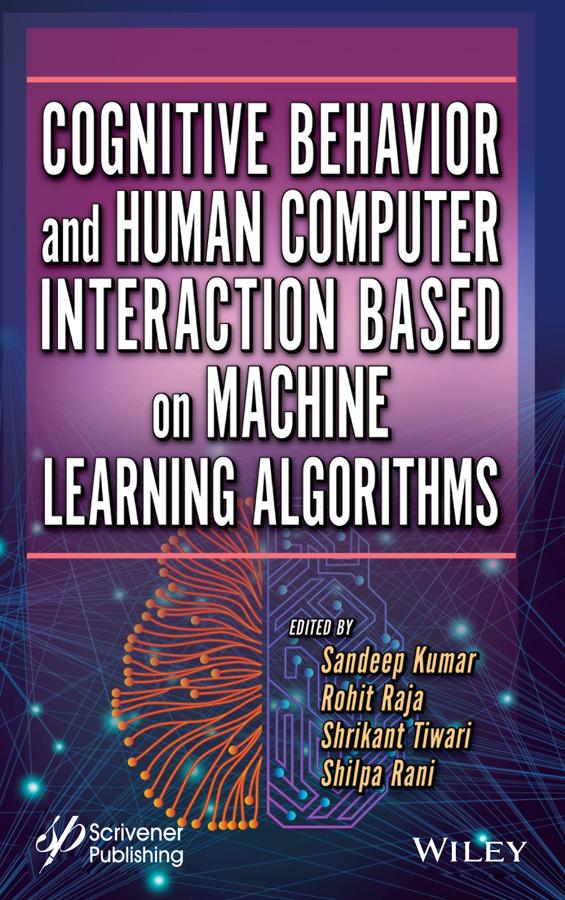Cognitive Behavior and Human Computer Interaction Based on Machine Learning Algorithms Sandeep Kumar
Visit to download the full and correct content document: https://ebookmass.com/product/cognitive-behavior-and-human-computer-interactionbased-on-machine-learning-algorithms-sandeep-kumar/
More products digital (pdf, epub, mobi) instant download maybe you interests ...
Machine Learning for Biometrics: Concepts, Algorithms and Applications (Cognitive Data Science in Sustainable Computing) Partha Pratim Sarangi
https://ebookmass.com/product/machine-learning-for-biometricsconcepts-algorithms-and-applications-cognitive-data-science-insustainable-computing-partha-pratim-sarangi/
Research methods in human-computer interaction 2 ed Edition Feng
https://ebookmass.com/product/research-methods-in-human-computerinteraction-2-ed-edition-feng/
Introduction to algorithms for data mining and machine learning Yang
https://ebookmass.com/product/introduction-to-algorithms-fordata-mining-and-machine-learning-yang/
Fundamentals of Machine Learning for Predictive Data Analytics: Algorithms,
https://ebookmass.com/product/fundamentals-of-machine-learningfor-predictive-data-analytics-algorithms/
Machine Learning Algorithms for Signal and Image Processing Suman Lata Tripathi
https://ebookmass.com/product/machine-learning-algorithms-forsignal-and-image-processing-suman-lata-tripathi/
Machine Vision Inspection Systems, Machine LearningBased Approaches Muthukumaran Malarvel
https://ebookmass.com/product/machine-vision-inspection-systemsmachine-learning-based-approaches-muthukumaran-malarvel/
Introduction to Algorithms for Data Mining and Machine Learning Xin-She Yang
https://ebookmass.com/product/introduction-to-algorithms-fordata-mining-and-machine-learning-xin-she-yang/
Demystifying Big Data, Machine Learning, and Deep Learning for Healthcare Analytics Pradeep N Sandeep Kautish Sheng-Lung Peng
https://ebookmass.com/product/demystifying-big-data-machinelearning-and-deep-learning-for-healthcare-analytics-pradeep-nsandeep-kautish-sheng-lung-peng/
Predicting Heart Failure : Invasive, Non-Invasive, Machine Learning, and Artificial Intelligence Based Methods 1st Edition Kishor Kumar Sadasivuni
https://ebookmass.com/product/predicting-heart-failure-invasivenon-invasive-machine-learning-and-artificial-intelligence-basedmethods-1st-edition-kishor-kumar-sadasivuni/
Table of Contents
Cover Title page
Copyright Preface
1 Cognitive Behavior: Different Human-Computer Interaction Types
1.1 Introduction: Cognitive Models and Human-Computer User Interface Management Systems
1.2 Cognitive Modeling: Decision Processing User Interacting Device System (DPUIDS)
1.3 Cognitive Modeling: Decision Support User Interactive Device Systems (DSUIDS)
1.4 Cognitive Modeling: Management Information User Interactive Device System (MIUIDS)
1.5 Cognitive Modeling: Environment Role With User Interactive Device Systems
1.6 Conclusion and Scope References
2 Classification of HCI and Issues and Challenges in Smart Home HCI Implementation
2.1 Introduction
2.2 Literature Review of Human-Computer Interfaces
2.3 Programming: Convenience and Gadget Explicit Substance
2.4 Equipment: BCI and Proxemic Associations
2.5 CHI for Current Smart Homes
2.6 Four Approaches to Improve HCI and UX
2.7 Conclusion and Discussion References
3 Teaching-Learning Process and Brain-Computer Interaction Using ICT Tools
3.1 The Concept of Teaching
3.2 The Concept of Learning
3.3 The Concept of Teaching-Learning Process
3.4 Use of ICT Tools in Teaching-Learning Process
3.5 Conclusion References
4 Denoising of Digital Images Using Wavelet-Based Thresholding Techniques: A Comparison
4.1 Introduction
4.2 Literature Survey
4.3 Theoretical Analysis
4.4 Methodology
4.5 Results and Discussion
4.6 Conclusions References
5 Smart Virtual Reality–Based Gaze-Perceptive Common Communication System for Children With Autism Spectrum Disorder
5.1 Need for Focus on Advancement of ASD Intervention Systems
5.2 Computer and Virtual Reality–Based Intervention Systems
5.3 Why Eye Physiology and Viewing Pattern Pose Advantage for Affect Recognition of Children With ASD
5.4 Potential Advantages of Applying the Proposed Adaptive Response Technology to Autism Intervention
5.5 Issue
5.6 Global Status
5.7 VR and Adaptive Skills
5.8 VR for Empowering Play Skills
5.9 VR for Encouraging Social Skills
5.10 Public Status
5.11 Importance
5.12 Achievability of VR-Based Social Interaction to Cause Variation in Viewing Pattern of Youngsters With ASD
5.13 Achievability of VR-Based Social Interaction to Cause Variety in Eye Physiological Indices for Kids With ASD
5.14 Possibility of VR-Based Social Interaction to Cause Variations in the Anxiety Level for Youngsters With ASD References
6 Construction and Reconstruction of 3D Facial and Wireframe Model Using Syntactic Pattern Recognition
6.1 Introduction
6.2 Literature Survey
6.3 Proposed Methodology
6.4 Datasets and Experiment Setup
6.5 Results
6.6 Conclusion References
7 Attack Detection Using Deep Learning–Based Multimodal Biometric Authentication System
7.1 Introduction
7.2 Proposed Methodology
7.3 Experimental Analysis
7.4 Conclusion and Future Scope References
8 Feature Optimized Machine Learning Framework for Unbalanced Bioassays
8.1 Introduction
8.2 Related Work
8.3 Proposed Work
8.4 Experimental
8.5 Result and Discussion
8.6 Conclusion
References
9 Predictive Model and Theory of Interaction
9.1 Introduction
9.2 Related Work
9.3 Predictive Analytics Process
9.4 Predictive Analytics Opportunities
9.5 Classes of Predictive Analytics Models
9.6 Predictive Analytics Techniques
9.7 Dataset Used in Our Research
9.8 Methodology
9.9 Results
9.10 Discussion
9.11 Use of Predictive Analytics
9.12 Conclusion and Future Work
References
10 Advancement in Augmented and Virtual Reality
10.1 Introduction
10.2 Proposed Methodology
10.3 Results
10.4 Conclusion References
11 Computer Vision and Image Processing for Precision Agriculture
11.1 Introduction
11.2 Computer Vision
11.3 Machine Learning
11.4 Computer Vision and Image Processing in Agriculture
11.5 Conclusion References
12 A Novel Approach for Low-Quality Fingerprint Image Enhancement Using Spatial and Frequency Domain Filtering Techniques
12.1 Introduction
12.2 Existing Works for the Fingerprint Ehancement
12.3 Design and Implementation of the Proposed Algorithm
12.4 Results and Discussion
12.5 Conclusion and Future Scope References
13 Elevate Primary Tumor Detection Using Machine Learning
13.1 Introduction
13.2 Related Works
13.3 Proposed Work
13.4 Experimental Investigation
13.5 Result and Discussion
13.6 Conclusion
13.7 Future Work References
14 Comparative Sentiment Analysis Through Traditional and Machine Learning-Based Approach
14.1 Introduction to Sentiment Analysis
14.2 Four Types of Sentiment Analyses
14.3 Working of SA System
14.4 Challenges Associated With SA System
14.5 Real-Life Applications of SA
14.6 Machine Learning Methods Used for SA
14.7 A Proposed Method
14.8 Results and Discussions
14.9 Conclusion References
15 Application of Artificial Intelligence and Computer Vision to Identify Edible Bird’s Nest
15.1 Introduction
15.2 Prior Work
15.3 Auto Grading of Edible Birds Nest
15.4 Experimental Results
15.5 Conclusion
Acknowledgments
References
16 Enhancement of Satellite and Underwater Image Utilizing Luminance Model by Color Correction Method
16.1 Introduction
16.2 Related Work
16.3 Proposed Methodology
16.4 Investigational Findings and Evaluation
16.5 Conclusion
References
Index
End User License Agreement
List of Figures
Chapter 1
Figure 1.1 Cognitive behavioral elements of broad view of human-computer interfa...
Figure 1.2 Decision processing system user interface device management as extern...
Figure 1.3 Cognitive modeling process in the visualization decision processing u...
Figure 1.4 Supporting cognitive model for the interaction of decision supportive...
Figure 1.5 Basic elements of management information user interactive device syst...
Figure 1.6 Model of memory, information passes through distinct stages in order ...
Chapter 2
Figure 2.1 The utility of HCI.
Figure 2.2 The basic of HCI and related spaces.
Figure 2.3 The making of intelligent ease of use.
Figure 2.4 The connected fields of HCI and ease of use designing.
Figure 2.5 Pictured models of smart devices, (a) Model-1 (b) Model-2 (c) Model-3...
Chapter 3
Figure 3.1 Human brain bisected in the sagittal plane.
Figure 3.2 Functional areas of the human brain.
Figure 3.3 Parts of the human ear.
Figure 3.4 Regenerative feedback system of the teachinglearning process.
Figure 3.5 Conceptual diagram of the teaching-learning process.
Figure 3.6 Structure of a neuron.
Figure 3.7 Block diagram of a typical neurofeedback system.
Figure 3.8 BCI architecture.
Chapter 4
Figure 4.1 PDF of Gaussian noise.
Figure 4.2 Single-level decomposition of 2D image.
Figure 4.3 Single-level DWT decomposition.
Figure 4.4 Three-level DWT decomposition.
Figure 4.5 Single-level composition step of four subimages.
Figure 4.6 Filter arrangement for the dual-tree complex wavelet transform.
Figure 4.7 Hard thresholding scheme: (a) original signal and (b) after hard thre...
Figure 4.8 Soft thresholding scheme: (a) original signal and (b) after soft thre...
Figure 4.9 Neighborhood window centered at thresholded wavelet coefficient.
Figure 4.10 2 x 2 block partition for a wavelet sub-band.
Figure 4.11 Image denoising using DTCWT-based thresholding technique.
Figure 4.12 Flow chart for the wavelet-based thresholding technique.
Figure 4.13 Standard gray images (512 × 512): (a) lena image; (b) barbara image;...
Figure 4.14 (a) Noisy image (noise level = 10); (b) Denoise image (SURE shrink);...
Figure 4.15 PSNR values obtained various thresholding techniques.
Figure 4.16 SSIM values obtained various thresholding techniques.
Chapter 6
Figure 6.1 Block diagram of the proposed methodology.
Figure 6.2 (a) Original image. (b) Face detection from the right angle using Vio...
Figure 6.3 3D wireframe concerning central cell 14.
Figure 6.4 (a) 3 x 3 x 3 size of voxels array. (b) Smallest possible three-dimen...
Figure 6.5 Comparative analysis of proposed algorithm with existing technique on...
Figure 6.6 Comparative analysis of error maps for 3D detailed reconstruction. Th...
Figure 6.7 Reconstruction result of USF dataset. The numbers under error image r...
Chapter 7
Figure 7.1 Hierarchy of biometric traits [2].
Figure 7.2 Block diagram of the proposed methodology.
Figure 7.3 Proposed framework for expert one.
Figure 7.4 Proposed framework for expert two.
Chapter 8
Figure 8.1 Machine learning framework.
Figure 8.2 Comparison of machine learning structure with classifiers using accur...
Chapter 9
Figure 9.1 Predictive analytics process.
Figure 9.2 Decision tree.
Figure 9.3 Regression model.
Figure 9.4 Artificial Neural Network.
Figure 9.5 Bayesian statistics.
Figure 9.6 Ensemble classifier.
Figure 9.7 Gradient boosting.
Figure 9.8 Support Vector Machine.
Figure 9.9 Time series analysis.
Figure 9.10 Regression utilizing k-NN.
Figure 9.11 Principle component analysis.
Chapter 10
Figure 10.1 Virtual continuum.
Figure 10.2 Research strategies followed.
Figure 10.3 Advancement of publications.
Figure 10.4 Development of AR and VR advancements in the cycle of hype.
Figure 10.5 Advancement of games published in STEAM.
Figure 10.6 On the top is the level of nations which made an exploration on AR o...
Figure 10.7 Examination of papers picked step by step: Ihe blue line is the rela...
Figure 10.8 Conveyance of developed fields.
Figure 10.9 Publications development, everything being equal.
Figure 10.10 Publications in R&D by nations.
Figure 10.11 Data about distributions on medical care: The upper left picture is...
Figure 10.12 Data about educational publications: in the upper left picture is t...
Figure 10.13 Data about distributions on the industry: The upper left picture is...
Chapter 11
Figure 11.1 Basic ANN architecture.
Figure 11.2 Vision-based vehicle navigation system.
Figure 11.3 The contadino autonomous implement carrier can be used for seeding, ...
Figure 11.4 Swarm size agriculture robots [60].
Chapter 12
Figure 12.1 Flowchart of proposed algorithm. Workflow diagram.
Figure 12.2 (a) Original image (DB1 107_2.tif). (b) Coherence filter. (c) Gabor ...
Figure 12.3 (a) Original image. (b) Proposed algorithm using a thinning techniqu...
Chapter 13
Figure 13.1 Diagrammatical view.
Figure 13.2 (a-d) is Performance evaluation on state of art parameters.
Chapter 14
Figure 14.1 Five tuples used to evaluate sentiment.
Figure 14.2 ttree values of sentiment.
Figure 14.3 Types of sentiments.
Figure 14.4 Architecture of SA system.
Figure 14.5 Challenges of sentiment classifier.
Figure 14.6 Real-life applications of sentiment analysis.
Figure 14.7 Framework for the proposed model.
Figure 14.8 Comparison chart of different classifiers for different datasets.
Chapter 15
Figure 15.1 Shapes of EBN of grade AA, grade A, and grade B. Adapted from [4].
Figure 15.2 Block diagram for feature extraction.
Figure 15.3 Histogram of intensities of saturation layer for various grades.
Figure 15.4 Original images (top row) and the impurities detected (bottom row) f...
Figure 15.5 Original image (top row) and HSV colour model (bottom row) of EBNs (...
Figure 15.6 Original images (top row) and the area detected for each image (bott...
Chapter 16
Figure 16.1 Proposed approach block diagram.
Figure 16.2 Similarity among proposed and existing techniques.
Figure 16.3 Entropy measured using the proposed method.
Figure 16.4 Time measured using the proposed method.
Figure 16.5 Investigational datasets.
Figure 16.6 Comparison of outcome between proposed and existing techniques.
Figure 16.7 The outcome appears utilizing proposed GUI on picture (h).
Figure 16.8 Outcome appears utilizing proposed GUI on picture (g).
Figure 16.9 Outcome appears utilizing proposed GUI on picture (e).
Figure 16.10 Outcome appears utilizing proposed GUI on picture (f).
List of Table
Chapter 1
Table 1.1 The core artifacts provided at the cognitive modeling of user interact...
Table 1.2 Representational uses of cognitive modeling for decision support user ...
Chapter 4
Table 4.1 PSNR values for grayscale images (512×512) for different values of AWG...
Table 4.2 SSIM values for grayscale images (512×512) for different values of AWG...
Chapter 6
Table 6.1 Study of existing methodology.
Table 6.2 Sample of possible convex polyhedrons.
Table 6.3 Comparative analysis of mean and standard deviation of point to point ...
Chapter 7
Table 7.1 LivDet 2015 dataset details.
Table 7.2 LivDet 2015 dataset details.
Chapter 8
Table 8.1 Exhibition correlation of enhanced multilayer perception by different ...
Chapter 9
Table 9.1 The solid ability sets as controlled by area specialists.
Table 9.2 The after-effects of the PCA examination. All highlights aside from Z-...
Table 9.3 The coefficients and noteworthiness estimations of the summed up segme...
Table 9.4 The models developed from highlights in the critical summed up parts. ...
Chapter 10
Table 10.1 Search measure synopsis.
Table 10.2 Evolution of publications houses.
Table 10.3 Outline of EU and USA publications by topics.
Chapter 11
Table 11.1 Cameras used in precision agriculture application.
Table 11.2 Plant and fruit detection techniques.
Table 11.3 Fruit grading and ripeness detection approaches.
Table 11.4 Fruit counting and yield prediction.
Table 11.5 Weed and disease detection.
Chapter 12
Table 12.1 Texture descriptor results for FVC2004DB1 107_2.tif.
Table 12.2 Texture descriptor results for FVC2004DB2 101_2.tif.
Table 12.3 Texture descriptor results for FVC2004DB3 107_7.tif.
Table 12.4 Texture descriptor results for FVC2004DB4 110_8.tif.
Table 12.5 Minutiae ratio results for the thinning technique.
Table 12.6 Minutiae ratio results for mindset technique.
Table 12.7 Minutiae ratios obtained for the proposed algorithm using the thinnin...
Table 12.8 Minutiae ratios obtained for the proposed algorithm using the mindset...
Chapter 13
Table 13.1 Comparison of performance of applied classifiers using certain specif...
Table 13.2 Analytical estimation of selected attributes.
Chapter 14
Table 14.1 Dataset statistics.
Table 14.2 Performance comparison of different classifiers for the IMDB dataset ...
Table 14.3 Performance comparison of different classifiers for Amazon product re...
Table 14.4 Performance comparison of different classifiers for news headlines da...
Table 14.5 Performance comparison of different classifiers for online blogs data...
Table 14.6 Performance comparison of different classifiers for Wikipedia dataset...
Table 14.7 Accuracy comparison of different classifiers for different datasets.
Chapter 15
Table 15.1 Features extracted for various grades.
Table 15.2 Classification accuracies for various radii of subtractive clustering...
Table 15.3 Accuracies for FCM with different clusters.
Table 15.4 Sensitivity of the neural net with different number of hidden neurons...
Table 15.5 Auto-grading accuracies (%).
Table 15.6 Maximum and minimum classification accuracies (%).
Table 15.7 Best classification accuracies.
Chapter 16
Table 16.1 Comparative analysis of submerged images.
Table 16.2 Proposed method time and entropy measured value.
Scrivener Publishing
100 Cummings Center, Suite 541J
Beverly, MA 01915-6106
Publishers at Scrivener
Martin Scrivener (martin@scrivenerpublishing.com)
Phillip Carmical (pcarmical@scrivenerpublishing.com)
Cognitive Behavior and Human Computer Interaction Based on Machine Learning Algorithm
Edited by Sandeep Kumar
Rohit Raja
Shrikant Tiwari
Shilpa Rani
This edition first published 2022 by John Wiley & Sons, Inc., 111 River Street, Hoboken, NJ 07030, USA and Scrivener Publishing LLC, 100 Cummings Center, Suite 541J, Beverly, MA 01915, USA
© 2022 Scrivener Publishing LLC
For more information about Scrivener publications please visit www.scrivenerpublishing.com.
All rights reserved. No part of this publication may be reproduced, stored in a retrieval system, or transmitted, in any form or by any means, electronic, mechanical, photocopying, recording, or otherwise, except as permitted by law. Advice on how to obtain permission to reuse material from this title is available at http://www.wiley.com/go/permissions.
Wiley Global Headquarters
111 River Street, Hoboken, NJ 07030, USA
For details of our global editorial offices, customer services, and more information about Wiley products visit us at www.wiley.com.
Limit of Liability/Disclaimer of Warranty
While the publisher and authors have used their best efforts in preparing this work, they make no representations or warranties with respect to the accuracy or completeness of the contents of this work and specifically disclaim all warranties, including without limitation any implied warranties of merchant-ability or fitness for a particular purpose. No warranty may be created or extended by sales representatives, written sales materials, or promotional statements for this work. The fact that an organization, website, or product is referred to in this work as a citation and/or potential source of further information does not mean that the publisher and authors endorse the information or services the organization, website, or product may provide or recommendations it may make. This work is sold with the understanding that the publisher is not engaged in rendering professional services. The advice and strategies contained herein may not be suitable for your situation. You should consult with a specialist where appropriate. Neither the publisher nor authors shall be liable for any loss of profit or any other commercial damages, including but not limited to special, incidental, consequential, or other damages. Further, readers should be aware that websites listed in this work may have changed or disappeared between when this work was written and when it is read.
Library of Congress Cataloging-in-Publication Data
ISBN 978-1-119-79160-7
Cover image: Pixabay.Com
Cover design by Russell Richardson
Set in size of 11pt and Minion Pro by Manila Typesetting Company, Makati, Philippines
Preface
Human-computer interaction (HCI) is the academic discipline, which most of us think of as UI design, that focuses on how human beings and computers interact at ever-increasing levels of both complexity and simplicity. Because of the importance of the subject, this book aims to provide more relevant information that will be useful to students, academics, and researchers in the industry who wish to know more about its realtime application. In addition to providing content on theory, cognition, design, evaluation, and user diversity, this book also explains the underlying causes of the cognitive, social and organizational problems typically devoted to descriptions of rehabilitation methods for specific cognitive processes. Also described are the new modeling algorithms accessible to cognitive scientists from a variety of different areas. Advances in HCI involve interdisciplinary research, the results of which are published in theoretical and applied articles covering a broad spectrum of interactive systems. Therefore, this book is inherently interdisciplinary and publishes original research in computing, engineering, artificial intelligence, psychology, linguistics, and social and system organization as applied to the design, implementation, application, analysis, and evaluation of interactive systems. Since machine learning research has already been carried out for a decade at the international level in various applications, the new learning approach is mainly used in machine learning-based cognitive applications. Since this will direct the future research of scientists and researchers working in neuroscience, neuroimaging, machine learning-based brain mapping and modeling, etc., this book highlights the framework of a novel robust method for advanced cross-industry HCI technologies. These implementation strategies and future research directions will meet the design and application requirements of several modern and realtime applications for a long time to come. Therefore, this book will be a better choice than most available books that were published a long time ago, and hence seldom elaborate on the current
advancements necessary for cognitive behavior and HCI algorithms. Included in the book are:
A review of the state-of-the-art in cognitive behavior and HCI processing models, methods, techniques, etc.
A review and description of the learning methods in HCI.
The new techniques and applications in cognitive behavior along with their practical implementation.
The existing and emerging image challenges and opportunities in the cognitive behavior and HCI field.
How to promote mutual understanding and networking among researchers in different disciplines.
The facilitation of future research development and collaborations.
Real-time applications.
To conclude, we would like to express our appreciation to all of the contributing authors who helped us tremendously with their contributions, time, critical thoughts, and suggestions to put together this peer-reviewed edited volume. The editors are also thankful to Scrivener Publishing and its team members for the opportunity to publish this volume. Lastly, we thank our family members for their love, support, encouragement, and patience during the entire period of this work.
Sandeep Kumar
Rohit Raja
Shrikant Tiwari
Shilpa Rani
October 2021
1 Cognitive Behavior: Different HumanComputer Interaction Types
S. Venkata Achyuth Rao1*, Sandeep Kumar2 and GVRK
Acharyulu3
1CSE, SIET, Hyderabad, Telangana, India
2Computer Science and Engineering Department, Koneru Lakshmaiah Education Foundation, Vaddeswaram, Andra Pradesh, India
3Operations & Supply Chain, MBA (Healthcare & Hospital Management), School of Management Studies, University of Hyderabad, Telangana, India
*Corresponding author: drsvarao@gmail.com
Abstract
Cognitive behavior plays a significant and strategic role in humancomputer interaction devices that are deployed nowadays, with artificial intelligence, deep learning, and machine learning computing techniques. User experience is the crucial factor of any successful interacting device between machine and human. The idea of providing a HCUIMS is to create interfaces in terms of the bottom level of any organization as Decision Processing User Interacting Device System (DPUIDS), next at middle level management, Decision Support User Interacting Device Systems (DSUIDS), lastly at executive level, Management Information User Interacting Device System (MIUIDS), where decisions can take at uncertainty at various catastrophic situations. Here are specific gaps demonstrated in the various user’s processes in communicating with computers and that cognitive modeling is useful in the inception phase to evolve the design and provide training.
This is provided with the fulfillment of various interactive devices like Individual Intelligences Interactions (I3), Artificial and Individual Intelligences Interaction (AI3), Brain-Computer Interaction (BCI), and Individual Interactions through Computers (I2C) in a playful manner to meet the corporate challenges in all stakeholders of various domains with better user experience.
Keywords: Cognitive behavior, user experience, interacting devices, modeling, intelligence
1.1 Introduction: Cognitive Models and HumanComputer User Interface Management Systems
Cognitive models are useful in assessing to make predictions ease at top-level management systems in several aspects or many variables to interact and provide the approximate behavioral aspects observed in various experimental empirical studies. In a real-world lifetime situation, many factors are influenced to produce outcome reports as a behavioral analysis report. This is done neural processing data with the representation of patterns. These models outcome in terms of processes and products interact with various people which are shown
in the empirical experiments. These below are necessary tools for psychologists to interact with various designers who care about cognitive models. These models for HCI have an adequate different goal to use necessary interfaces better for users. In general, there are at least three cognitive models in service as a general goal [1].
Interactive user behavioral predicting systems
Adaptive interaction observatory changing systems
Group interaction model building systems
1.1.1 Interactive User Behavior Predicting Systems
Human behavior predicting system interface is designed and deployed as the interaction and communication between users and a machine, an automatic dynamic, versatile system, through a usermachine interface [2]. There are strongly related real-world assumptions, and aspects are there to distinguish the domain of user-machine automatic dynamic, versatile systems, and usercomputer interaction. For 50 years onward, the investigations on research in this domain are going on with different interactive human predicting systems that are evolved with the necessary propagated embedded events via a hardware and software interaction built-in displays. The best and emerging ambient designs of user interaction automatic predicting system applications have a right market place and gain values vertically in all the verticals for many products and services in various sectors like medical, transportation, education, games, and entertainment, which are the needs of the industry [3].
1.1.2 Adaptive Interaction Observatory Changing Systems
An adaptive interactive observatory system acquires its psychological aspects to the independent user based on inferences of the user prototype acquisition and reports involving activity in learning, training, inference, or necessary constraints of the decision process. The primary and needful goal of adaptive interaction observatory
changing system interfacing adaptation is to consider unique perceptual or physical impairments of individual users; it allowed them to use a dynamic system more flexibly, efficiently, with minimal errors and with less frustration. An adaptive interaction observatory system interface is an embedded software artifact that improves its functionality to interact with an individual user by prototype model, thereby constructing a user model based on partial psychological considerable experience with that user [4].
As there are widespread of www, internet, and gopher services among the population day by day, more sophisticated variety of softwares, emerging technologies involve hardware events, gadgets, widgets, and events that are more and more highly interactive and responsive. Only limited early individual novice people are doing programs on punch cards and submitting late nights and overnight jobs, and subsequently time-sharing systems and debug monitors, text editors have become slower and slower and depend on multiple cores and moving forward to parallel processing. The latest emerging operating systems and real-time operating systems support various interactive software like what you see and what you get. The editor system software is too high for interactive computer games, most efficient and eminent embedded systems, automotive responsive, interactive, and adaptive conservative systems in layered interactive graphical user interfaces, and such subscribers and listeners are the key roles of adaptive interaction observatory changing systems. Such systems have been treated as an essential part of any business and academic lives with a trillion people depend on them to move toward their daily lives. Most academic work on machine learning still focuses on refining techniques and humiliating the steps that may happen at foreseen and after their invocation. Indeed, most investigations, conferences, workshops, and research interests, especially media and entertainment, virtual reality, simulation, modeling, and design, still emphasize differences between broader areas of learning methods. Eventually, evidenced by the decision-tree induction, the design analysis of algorithms, case-based reasoning methods, and statistical and probabilistic schemes often produce very similar results [5].
1.1.3 Group Interaction Model Building Systems
This chapter’s main objective is to describe the existing cognitive framework activities on group modeling information systems using synergy responsive dynamics. Such information systems are very few and necessary to be applied in hybrid organizations in order to support to increase in a wide range of business expansion and to take their strategic decisions. In this cognitive group interaction model building theory, the vital methodological dynamics were first located under the individual user interactions and then classified to allow an intensive idea to be given as a requirement analysis report for group activity prototype being a building system consideration [6]. The outcome of this brainstorming dynamics indicates the existing methods to propose a global view of interaction model systems are very rare. Also, three complex issues are needed to discuss: the inception of knowing the users’ knowledge, the interaction establishment of a consensus among users, and the main aspects of providing necessary facilitation.
A group interaction model building system is a dynamic system that is characterized by the following:
1. The responsive nature and strong interactions among the actors of the group;
2. An integration exists with necessary interactions, interrelations, and a strong dependency together;
3. An internal abstractive complex cohesiveness is subjected to their feedback; and
4. Fuzziness of the delayed behavioral reactions among the groups to assess or predict.
An organized framework is described here as a generalization of any organized approach, providing inference process and cohesive interactions in the detailed guidelines related to any aspect of group interaction model building. This analysis aims to obtain a broad view of a global vision of investigating the research that applied group interaction modeling systems. Using system dynamics allows drawing keenness to the lack of advanced interactive device management aspects to support the relating behavior aspects.
The group modeling system approach’s dynamic behavior is characterized below, emphasizing group interaction model systems. The modeling process using two types of information systems [7]:
1. Modeling information systems versus group interaction model information systems.
2. Expert modeling systems versus team expert modeling information systems.
1.1.4 Human-Computer User Interface Management Systems
Human-Computer User Interface (HCUI) design mainly emphasizes foreseeing what computer interaction users need to do and approve that the human-computer interface has several elements that are flexible and easy to know, view, navigate, update, manage and modify, and use to provide facilitation in the form of events and widgets. HCUI accomplishes the related features from interpreting, layout design, interaction design, visual design, and information architecture.
A HCUIMS (HCUI Management System) is treated as not as a system but rather an interactive software architecture (an HCUIMS is also called a HCUI Architecture) “in which the design, deployment of various applications’ user interface is precise and clearly distinguished from that of other applications’ underlying its functionality.” Such an eminent division’s cohesive objective is to enhance the maintenance ease and adaptability with other softwares. Most of the Modern HCUIMS Architectures are designed with integrated development environments. With the help of abstraction of a user interface from the applications logic, syntax, and semantics, the code generation is better supported for customization. Even these architectures have been proven and useful with a high degree of interaction and had semantic feedback at manipulating interfacing boundaries between applications and HCUIs are difficult or impossible to maintain [8].
1.1.5 Different Types of Human-Computer User Interfaces
1. Interface for Command Line
2. Interface for Menu Driven
3. Interface for Touch-Screen Driven
4. Interface for Graphical User Purpose
5. Interface for Event-Driven Purpose
6. Interface for Sensor-Based Users
7. Interface for Voice-Based Users
8. Interface for Natural Language Users
9. Interface for Form-Based Users
10. Interface for Gesture Driven Users
11. Interface for Mobile Users
12. Interface for Data Base Users
13. Interface for VR Design
1.1.6 The Role of User Interface Management Systems
User interface management system architecture’s role is broader than a narrow concern concerning hardware, embedded system software applications, design analysis and algorithms, software procedures, packages, distributed servers, and other programs. The majority of domains with respective disciplines are contributed widely to the discipline of management informative systems, including the following:
1. Traditional ancestor science and technology related disciplines such as functional forms, lambda expressions, predicative calculus, systems theory, operation research, and econometrics;
2. Technology such as electronics, information technology, bioinformatics, nano technology, and computer science;
3. Emerging technologies like security management studies that include cognitive networking, link taping, a man-in-the-middle attack, brute force, cross-site request forgery, and doom-based attack; and
4. Social engineering and behavioral theory of ergonomics, linguistics, etc.
User interface management systems development is exceptionally different because the Information Systems are to be continued adequate modeling and working staff need to serve an efficient role in the enterprise management system organizations [9]. The roles and responsibilities needed to be performed efficiently as given below. Some of them are discussed below.
1. Information system programmers and system analysts need to spare longer to interact with stakeholders individually or groupwise to elicit more useful information to design and evolve the system interaction meaningful and rapid responsive purpose.
2. Determine what information is useful to take decision-making in uncertain times is a challenging task. For this, information system staff forcing to spare longer time and a great deal to interact with system users.
3. Development and deployment approaches likely building prototyping models are based on either rapid application development model feedback or iterative, incremental feedback from connected users on interaction efficiency concerning their needs.
4. The resultant outcome in the form of Information is visualized as an essential asset by executive information system management people at the top-level directors.
5. The visualized information systems are displayed, not only at the given organizations but also use or deployed in many organizations, as it follows strategically rather than just had an operational role of the given organization.
